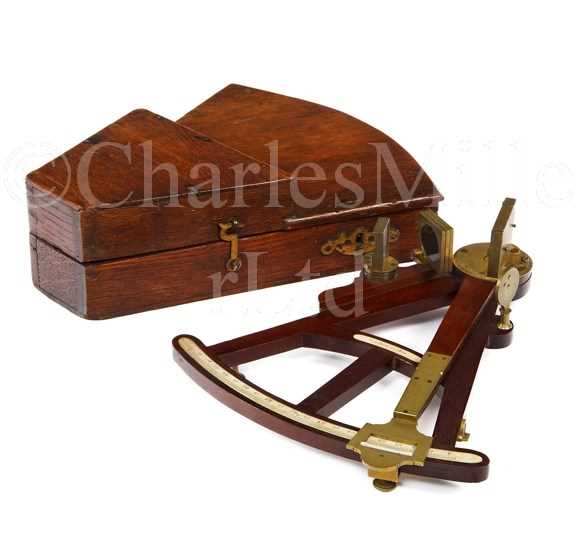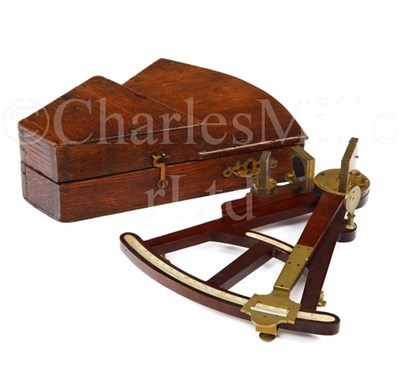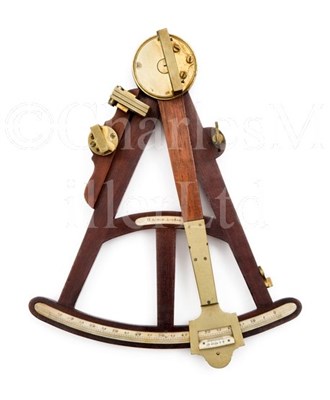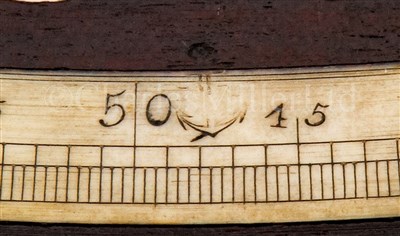1st May, 2013 12:00
Maritime and Scientific Models, Instruments & Art (Excellent)
214
[M] A RARE MINIATURE 8¾IN. RADIUS VERNIER OCTANT...
A RARE MINIATURE 8¾IN. RADIUS VERNIER OCTANT BY GEORGE ADAMS (II) WITH SCALE DIVIDED BY JESSE RAMSDEN, LONDON, CIRCA 1790
the mahogany 'T'-frame with inset ivory scale impressed at 50° with Ramsden's foul anchor mark flanked 'IR' divided -2°-0°-100°, signed on the cross bar G Adams. London, Vernier scale with right-aligned '0', arm stop, double pinhole sight, index mirror, three shades and adjustable horizon mirror and three pad feet, contained in original fitted stepped keystone box with ornate lock escutcheon and securing hook -- 12 x 10½in. (30.5 x 26.5cm.)
George Adams II (1750-1795) inherited the famous instrument making business established by his father (George Adams I 1720-1773) in 1772. He continued production of high-quality instruments and retained the title of Instrument Maker to the King (and the East India Company). This octant is one of the smallest examples seen and, for a maker such as Adams who by 1790 would have been producing brass-framed instruments, almost an anachronism. Possibly it was a special commission for a traditional seaman (yachtsman?) who wanted the trusted, old-style wooden instruments of yore, combined with the accuracy now available via Ramsden's engine and which allowed frames to shrink so dramatically.
Provenance: With Harriet Wynter Ltd, November 1979.
the mahogany 'T'-frame with inset ivory scale impressed at 50° with Ramsden's foul anchor mark flanked 'IR' divided -2°-0°-100°, signed on the cross bar G Adams. London, Vernier scale with right-aligned '0', arm stop, double pinhole sight, index mirror, three shades and adjustable horizon mirror and three pad feet, contained in original fitted stepped keystone box with ornate lock escutcheon and securing hook -- 12 x 10½in. (30.5 x 26.5cm.)
George Adams II (1750-1795) inherited the famous instrument making business established by his father (George Adams I 1720-1773) in 1772. He continued production of high-quality instruments and retained the title of Instrument Maker to the King (and the East India Company). This octant is one of the smallest examples seen and, for a maker such as Adams who by 1790 would have been producing brass-framed instruments, almost an anachronism. Possibly it was a special commission for a traditional seaman (yachtsman?) who wanted the trusted, old-style wooden instruments of yore, combined with the accuracy now available via Ramsden's engine and which allowed frames to shrink so dramatically.
Provenance: With Harriet Wynter Ltd, November 1979.
Sold for £4,712
Estimated at £3,000 - £5,000
(inc. buyer's premium of 24%)
A RARE MINIATURE 8¾IN. RADIUS VERNIER OCTANT BY GEORGE ADAMS (II) WITH SCALE DIVIDED BY JESSE RAMSDEN, LONDON, CIRCA 1790
the mahogany 'T'-frame with inset ivory scale impressed at 50° with Ramsden's foul anchor mark flanked 'IR' divided -2°-0°-100°, signed on the cross bar G Adams. London, Vernier scale with right-aligned '0', arm stop, double pinhole sight, index mirror, three shades and adjustable horizon mirror and three pad feet, contained in original fitted stepped keystone box with ornate lock escutcheon and securing hook -- 12 x 10½in. (30.5 x 26.5cm.)
George Adams II (1750-1795) inherited the famous instrument making business established by his father (George Adams I 1720-1773) in 1772. He continued production of high-quality instruments and retained the title of Instrument Maker to the King (and the East India Company). This octant is one of the smallest examples seen and, for a maker such as Adams who by 1790 would have been producing brass-framed instruments, almost an anachronism. Possibly it was a special commission for a traditional seaman (yachtsman?) who wanted the trusted, old-style wooden instruments of yore, combined with the accuracy now available via Ramsden's engine and which allowed frames to shrink so dramatically.
Provenance: With Harriet Wynter Ltd, November 1979.
the mahogany 'T'-frame with inset ivory scale impressed at 50° with Ramsden's foul anchor mark flanked 'IR' divided -2°-0°-100°, signed on the cross bar G Adams. London, Vernier scale with right-aligned '0', arm stop, double pinhole sight, index mirror, three shades and adjustable horizon mirror and three pad feet, contained in original fitted stepped keystone box with ornate lock escutcheon and securing hook -- 12 x 10½in. (30.5 x 26.5cm.)
George Adams II (1750-1795) inherited the famous instrument making business established by his father (George Adams I 1720-1773) in 1772. He continued production of high-quality instruments and retained the title of Instrument Maker to the King (and the East India Company). This octant is one of the smallest examples seen and, for a maker such as Adams who by 1790 would have been producing brass-framed instruments, almost an anachronism. Possibly it was a special commission for a traditional seaman (yachtsman?) who wanted the trusted, old-style wooden instruments of yore, combined with the accuracy now available via Ramsden's engine and which allowed frames to shrink so dramatically.
Provenance: With Harriet Wynter Ltd, November 1979.
Auction: Maritime and Scientific Models, Instruments & Art (Excellent), 1st May, 2013




